Difference between revisions of "Measures and weights"
| (9 intermediate revisions by one user not shown) | |||
| Line 4: | Line 4: | ||
| − | + | ==Units of measurement in leather== | |
| + | [[Leather]] is a natural material and hence not available in rolls like other fabrics. For this reason, the [[Parts of the hide|external contours of the animal skin]] are too irregular. Leather is measured and calculated in square metres, decimetres, square feet (inch: inches), lengthwise or in kilogrammes. When speaking of leather, it is common to use words like weight leather and surface leather while [[Leather strips - Leather laces - Leather straps|leather laces and leather strips]] are sold by length. | ||
| − | + | Leather [[Hide - Skin|skin]] has different [[leather quality|qualities]] within a skin making it impossible to sell the entire surface of the skin. These are sometimes cut in [[Parts of the hide|parts]] with different qualities and each [[Parts of the hide|section]] has corresponding technical terms. | |
| − | == | + | ==Leather surface measurement== |
| − | + | Large [[Hide - Skin|skins]], such as [[Cow leather|bovine skins]], are measured in square metres (m²). Occasionally, decimetres (dm²) are indicated. A [[Cow leather|cattle skin]] usually has 4.5 to 5.5 square metres. There are also larger (up to 6 sqm) and smaller skins. [[Leather dealer|Leather dealers]] mostly sell complete and half skins. For certain purposes, [[Leather cutting|further sections]] of the animal skin are sold. Smaller [[Leather cutting|sections]] are sold reluctantly, leading to higher [[leather cutting waste|waste during the cutting process]]. | |
<p align=center> | <p align=center> | ||
| − | [[bild:Haut-qm-01.jpg| | + | [[bild:Haut-qm-01.jpg|250px]] |
| − | [[bild:Haut-qm-06.jpg| | + | [[bild:Haut-qm-06.jpg|250px]] |
| − | + | ||
| − | + | ||
| − | + | ||
</p> | </p> | ||
<p align=center> | <p align=center> | ||
| − | + | [[bild:Haut-qm-02.jpg|500px]] | |
| + | </p> | ||
| + | <p align=center> | ||
| + | [[bild:Haut-qm-03.jpg|250px]] | ||
| + | [[bild:Haut-qm-04.jpg|250px]] | ||
| + | </p> | ||
| + | <p align=center> | ||
| + | ''For large hides, the measure is usually square metres. However, decimetres are also given.''<br></p> | ||
<p> </p> | <p> </p> | ||
<p align=center> | <p align=center> | ||
| − | [[bild:Fläche-messen-01.jpg| | + | [[bild:Fläche-messen-01.jpg|500px]] |
| − | [[bild:Gerberei-09.jpg| | + | </p> |
| + | <p align=center> | ||
| + | [[bild:Gerberei-09.jpg|500px]] | ||
| + | </p> | ||
| + | <p align=center> | ||
| + | [[bild:Leather-surface-size-scan-01.jpg|500px]] | ||
</p> | </p> | ||
<p align=center> | <p align=center> | ||
| − | ''In | + | ''In the [[tannery]] and during [[Leather cutting|cutting]], scanners measure the area of [[Parts of the hide|leather hides]].''<br></p> |
<p> </p> | <p> </p> | ||
<p align=center> | <p align=center> | ||
| − | [[bild: | + | [[bild:Half hide - full hide leather.jpg|500px]] |
</p> | </p> | ||
<p align=center> | <p align=center> | ||
| − | '' | + | ''[[Parts of the hide#Full hide - Half hide|Full hide - Half hide]]. The division takes place along the back line.''<br></p> |
<p> </p> | <p> </p> | ||
| − | + | [[Lamb leather|Lamb]], [[Pig leather|pig]] and [[goatskin]] in the [[leather clothing|clothing sector]] are usually measured in square feet or square inches. | |
| − | + | The conversion factor for the conversion from square metres to square feet is 10,764, from square metres to square inches 1550,003. | |
| − | ''' | + | '''Example:''' |
| − | 2,95 | + | 2,95 square metres x 10,764 = 31,75 square feet |
| − | 45 | + | 45 square feet: 10,764 = 4,18 square metres |
| − | + | For leathers sold by surface, the [[tanner]] has a great interest in trying to get the largest possible surface during the [[leather production|tanning process]]. | |
==Leather by weight== | ==Leather by weight== | ||
| − | + | Heavy leather, such as [[leather shoes#Sole leather|sole leather]], [[leather straps]] and [[bridle]] is calculated by weight. Also [[leather cutting waste|cutting waste]] is usually measured in kg. | |
| + | |||
| + | Irrespective of whether a leather is sold by weight or area, the [[leather production|work steps]] in the [[tannery]] and the tanning process have an influence on the weight of a leather. In a comparison of [[Chrome tanned|chrome tanning]], [[Synthetic tanned|synthetic tanning]] and [[Vegetable-tanned leather|vegetable tanning]], the area of tanned leather per 100 kilos of leather was measured. Chrome tanning was 18 m² per 100 kg, synthetic tanning 15 m² and vegetable tanning 13 m². With [[aircraft leather]], the goal is that the leather is [[Flammability and fire retardancy of leather|non-flammable]] and as light as possible. | ||
==Leather according to length== | ==Leather according to length== | ||
| − | [[Reptile leather]] | + | [[Reptile leather]] is calculated by length. |
==[[Thickness of leather|Leather thickness]]== | ==[[Thickness of leather|Leather thickness]]== | ||
| − | The [[Thickness of leather|leather thickness]] is measured in | + | The [[Thickness of leather|leather thickness]] is measured in millimetres with special measuring instruments. |
<p align=center> | <p align=center> | ||
| − | [[bild:Dicke3.jpg| | + | [[bild:Dicke3.jpg|500px]] |
| − | [[bild:Falzen-01.jpg| | + | </p> |
| + | <p align=center> | ||
| + | [[bild:Falzen-01.jpg|500px]] | ||
</p> | </p> | ||
<p align=center> | <p align=center> | ||
| Line 75: | Line 89: | ||
<p align=center> | <p align=center> | ||
| − | [[bild:Nietengurt-03-05.jpg| | + | [[bild:Nietengurt-03-05.jpg|500px]] |
| − | + | ||
</p> | </p> | ||
<p align=center> | <p align=center> | ||
| − | ''Leather can be over 6 mm [[Thickness of leather|thick.''<br></p> | + | [[bild:Tannery-butt.jpg|500px]] |
| + | </p> | ||
| + | <p align=center> | ||
| + | ''Leather can be over 6 mm [[Thickness of leather|thick]].''<br></p> | ||
<p> </p> | <p> </p> | ||
| − | |||
| − | |||
| − | |||
== Additional information == | == Additional information == | ||
| Line 95: | Line 108: | ||
| − | [Kategorie:All Articles]] | + | [[Kategorie:All Articles]] |
[[Kategorie:Leather production]] | [[Kategorie:Leather production]] | ||
[[Kategorie:Miscellaneous Leather items]] | [[Kategorie:Miscellaneous Leather items]] | ||
Latest revision as of 20:24, 19 April 2023
Contents
Units of measurement in leather
Leather is a natural material and hence not available in rolls like other fabrics. For this reason, the external contours of the animal skin are too irregular. Leather is measured and calculated in square metres, decimetres, square feet (inch: inches), lengthwise or in kilogrammes. When speaking of leather, it is common to use words like weight leather and surface leather while leather laces and leather strips are sold by length.
Leather skin has different qualities within a skin making it impossible to sell the entire surface of the skin. These are sometimes cut in parts with different qualities and each section has corresponding technical terms.
Leather surface measurement
Large skins, such as bovine skins, are measured in square metres (m²). Occasionally, decimetres (dm²) are indicated. A cattle skin usually has 4.5 to 5.5 square metres. There are also larger (up to 6 sqm) and smaller skins. Leather dealers mostly sell complete and half skins. For certain purposes, further sections of the animal skin are sold. Smaller sections are sold reluctantly, leading to higher waste during the cutting process.
For large hides, the measure is usually square metres. However, decimetres are also given.
In the tannery and during cutting, scanners measure the area of leather hides.
Full hide - Half hide. The division takes place along the back line.
Lamb, pig and goatskin in the clothing sector are usually measured in square feet or square inches.
The conversion factor for the conversion from square metres to square feet is 10,764, from square metres to square inches 1550,003.
Example:
2,95 square metres x 10,764 = 31,75 square feet
45 square feet: 10,764 = 4,18 square metres
For leathers sold by surface, the tanner has a great interest in trying to get the largest possible surface during the tanning process.
Leather by weight
Heavy leather, such as sole leather, leather straps and bridle is calculated by weight. Also cutting waste is usually measured in kg.
Irrespective of whether a leather is sold by weight or area, the work steps in the tannery and the tanning process have an influence on the weight of a leather. In a comparison of chrome tanning, synthetic tanning and vegetable tanning, the area of tanned leather per 100 kilos of leather was measured. Chrome tanning was 18 m² per 100 kg, synthetic tanning 15 m² and vegetable tanning 13 m². With aircraft leather, the goal is that the leather is non-flammable and as light as possible.
Leather according to length
Reptile leather is calculated by length.
Leather thickness
The leather thickness is measured in millimetres with special measuring instruments.
Measurement of leather thickness.
Leather can be over 6 mm thick.
Additional information







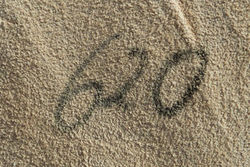
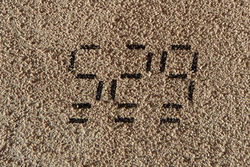
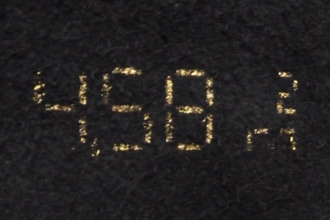
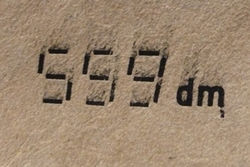
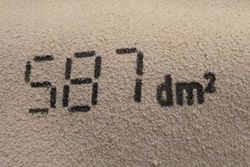
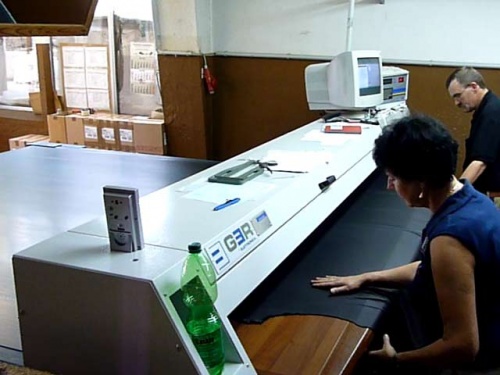
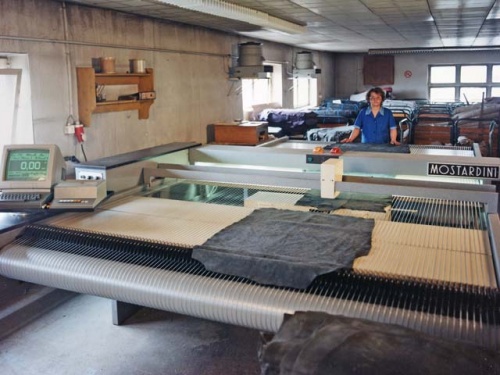
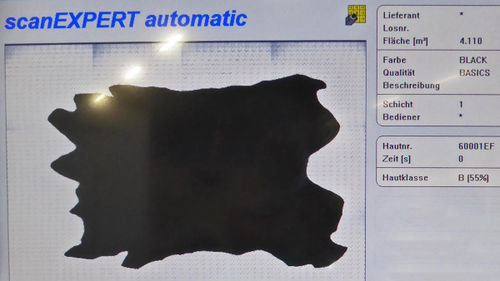
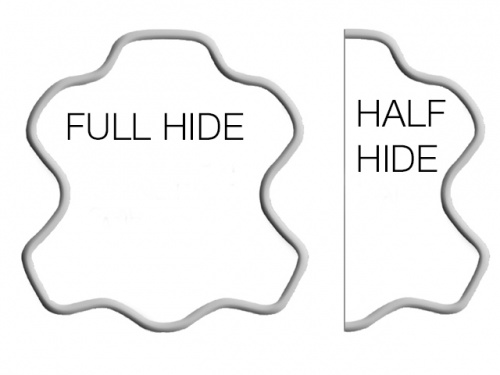
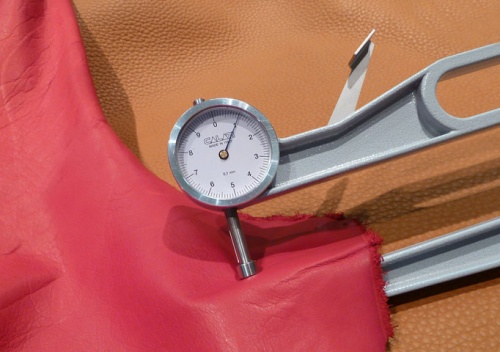
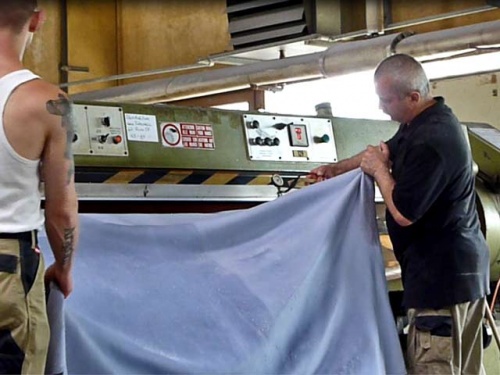
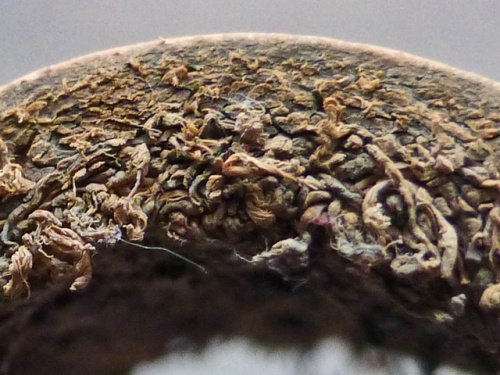
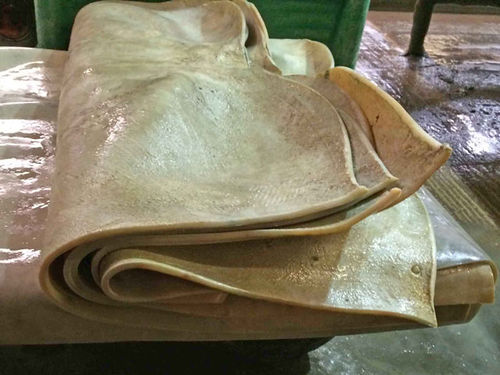

 a kotori web solution
a kotori web solution